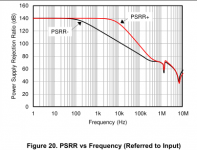I don't see how bringing the cost in changes any claim - its just a fact of life.
Indeed, that was my point, its a complete distraction 😀
(BTW are you still based in Hangzhou?)
Yep, still very much so.
We did a workshop at a facility that might have been a place once reserved for party officials since it was quite well appointed at West Lake in 2014 - beautiful place - very serene.
Could have been the 'Tea Museum' ? Superb location I seem to recall.
I think I bought my first CD player (CD-160) via a friend who worked at Philips (ex-Mullard factory in Southampton).
I think I bought my first CD player (CD-160) via a friend who worked at Philips (ex-Mullard factory in Southampton).
Last edited:
LIGO doesn't use discrete opamps. It must be for a good reason. 😉
sorry to be pedantic, but
Not too many 8 legs in LIGO the most important thing was noise especially 1/f in the laser power. Once down to the thermal motion of the atoms at the surface of the mirror the improvement comes elsewhere.
I still have a part of the CD67 pcb(the one with hdam circuits) and they were identical with the much revered CD-63 , basically the whole cd 67 was identical with the cd63 except the power transformer...Unfortunately the laser was dead so i scraped it for parts count 🙂I seem to recall this was just a vanilla VFA front end - LTP, Isource, single transistor+diode mirror driving IIRC straight into the VAS. I was quite surprised because they had made a big deal about HDAM at the time.
I used to get a c. $1000 'allowance' every 2 years to spend in the Philips (who owned Marantz at the time before selling it off to DM Holdings). I even got a cassette tape deck - 1998 - what was I thinking?
Optical amplifier - WikipediaNot too many 8 legs in LIGO the most important thing was noise especially 1/f in the laser power. Once down to the thermal motion of the atoms at the surface of the mirror the improvement comes elsewhere.
Also very high sensitivity transconductance amplifiers rely only on transistors in the first stage, but in a very tight thermally controlled environment, usually at very cold temperatures.
At some point we need different devices:
Optical transistor - Wikipedia
Last edited:
Not too many 8 legs in LIGO the most important thing was noise especially 1/f in the laser power. Once down to the thermal motion of the atoms at the surface of the mirror the improvement comes elsewhere.
Someone linked to a very nice write-up on the instrumentation that I can't find where they put all the orders of magnitude in into perspective re the signal levels and they described how the mirrors were suspended on special 3 order gimbal mounts etc.
I guess the mirrors are cooled?
Could have been the 'Tea Museum' ? Superb location I seem to recall.
I think I bought my first CD player (CD-160) via a friend who worked at Philips (ex-Mullard factory in Southampton).
They were tight as hell - I think they prices were 2 or 3% off what you could get on the street.
Someone linked to a very nice write-up on the instrumentation that I can't find where they put all the orders of magnitude in into perspective re the signal levels and they described how the mirrors were suspended on special 3 order gimbal mounts etc.
I guess the mirrors are cooled?
The Japanese are working on cryo mirrors. The big change here, I think, is the squeezed light which I don't understand at all.
Not necessarily so on DI or other modern processes, there are amps with Ccomp split 1/2 to each rail.
Yeah, I agree not necessarily so (hence my 'typically') and have seen such schematics in ADI's literature.
It happened over the years quite frequently that in case such evidence occurred that additional demands came up.
Of course, it is human nature. The cognitive literature is full of studies showing the effects of preexisting bias on accepting new information. People tend to accept results confirming their biases and preexisting beliefs, and reject results conflicting with their biases and preexisting beliefs. Interesting the reasons they can come up with to justify by argument a feeling that really comes from the gut (so to speak). Sometimes they will even say, "I know its wrong, but I don't know why."
Anyway, no wonder you have so much trouble trying to pin people down on what evidence they will accept. People intuitively know they may need some wiggle room later if a study turns out in way they don't feel comfortable with.
Ah but on PSRR is precisely where discrete can beat ICs. The reason being very simple - ICs have their Ccomp to the substrate typically and there's no 0V pin on an opamp. ... I've just remembered there is one fairly recent TI opamp which breaks with the 8pin tradition and does have a 0V connection. Can't recall its number though.
Here it is. SMD only, with thermal pad ---> not "socket compatible" with anything ---> invent your own idiosyncratic and incompatible pinout ---> no impact upon sales
_
Attachments
Here it is.
Thanks. It might just turn out to be worth all the incompatibility to experience that galactic level of PSRR goodness on the +ve rail. Wonder if I can find one locally.....😛
Ah, good news, someone's done all the donkey work for a pittance, I just need to figure out what they did with the 0V pin....
OPA1622 DIP8 ????? ??????-???
Attachments
Last edited:
Here's one https://dcc.ligo.org/public/0151/T1800133/004/T1800133-instrument-science-white-v4.pdf
See page 18
Squeezed light Squeezed states of light - Wikipedia
See page 18
Squeezed light Squeezed states of light - Wikipedia
Last edited:
Here it is. SMD only, with thermal pad ---> not "socket compatible" with anything ---> invent your own idiosyncratic and incompatible pinout ---> no impact upon sales
_
I actually like that pin layout!
Thanks. It might just turn out to be worth all the incompatibility to experience that galactic level of PSRR goodness on the +ve rail. Wonder if I can find one locally.....😛
Ah, good news, someone's done all the donkey work for a pittance, I just need to figure out what they did with the 0V pin....
OPA1622 DIP8 ????? ??????-???
Impressive. That's nearly 30dB better than an LM4562 at 20kHz on both rails.
Last edited:
I actually like that pin layout!
This is way op amp layout SHOULD be done. See fig. 60.
http://www.ti.com/lit/ds/symlink/opa1622.pdf
Nice one. Thank-you very much.Ah, good news, someone's done all the donkey work for a pittance, I just need to figure out what they did with the 0V pin....
OPA1622 DIP8 ????? ??????-???
It isn't? Do you have a proof of that?We should avoid to talk about "proof" as it isn´t possible to get this kind of certainty from any empirical process.
I'm trying to dust up my memory, did you state that you are in audio business?Furthermore, isn´t it unreasonable to demand evidence without being able to specify which kind of evidence would be accepted?
- Status
- Not open for further replies.
- Home
- Member Areas
- The Lounge
- John Curl's Blowtorch preamplifier part III

